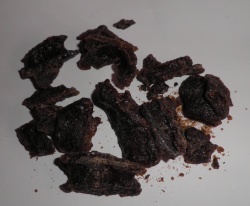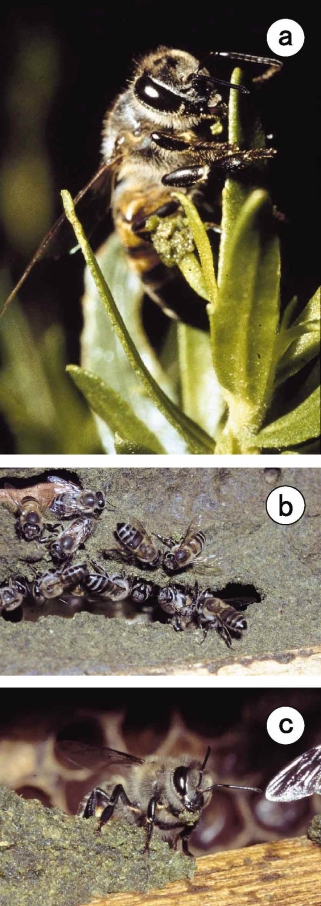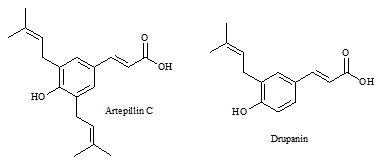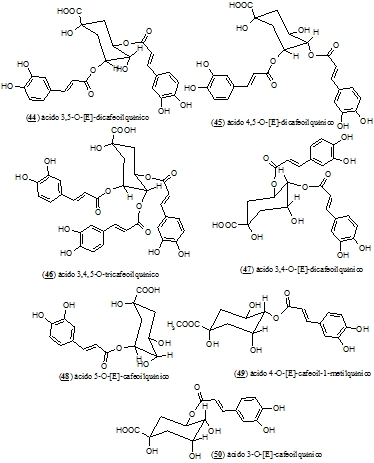Artigo cedido gentilmente pelo Professor Dr. Domingos Sávio Nunes
Universidade Estadual de Ponta Grossa
26 de agosto de 2012
Here, you can learn a little about the history of the first discoveries made in the Brazilian green propolis, its more important chemical components and bioactivity. Type of post: scientific and ethic discussion.
Aqui você pode conhecer um pouco sobre a história das primeiras descobertas feitas na própolis verde brasileira, seus mais importantes componentes químicos e sua bioatividade. Tipo de post: discussão científica e ética.
Chemical composition of Brazilian green propolis
Imagine if many people were sending from country A to country B, and for a very cheap price, several tons of a completely natural drug, free from synthetic chemicals, absolutely not dangerous, though little known, but considered by doctors as excellent remedy against numerous and serious problems that affect the health of many people in country B, such as cancer. The authorities of country B could even be in doubt whether they should fight or encourage the entry of such a wonderful drug, also because of the great interest in the industry… This story resembles what happened there by the early 1990s, with the Brazilian green propolis entering Japan.
An important scientific work of Japanese researchers on Brazilian green propolis, published in 1994, went straight to the bottom line: the 3,5-diprenyl-4-hydroxycinnamic acid (Artepillin C) was found in high proportions in crude ethanol extract and showed impressive antimicrobial activities (Reference 1). In 1998, a bombastic second article on the Artepillin C demonstrated strong activity against various strains of cancer (Reference 2).
After this bang, in 1999, at least two groups of Japanese researchers have come personally to Minas Gerais, Brazil, to make the first field observations and establish fully what is the botanical source of Brazilian green propolis. The first group consisted of researchers from University of Shizuoka and company Api Corporation Ltd.(Reference 3), and do not mention in their article any contact with Brazilian researcher or institution: it seems, beyond the limits of any ethics and only four years later published the details of what they did. The second group of Japanese researchers was from Toyama Medical and Pharmaceutical University and worked in cooperation with the University of Viçosa – MG, Brazil, in an analytical research comparing the chemical composition of Baccharis dracunculifolia leaves with Brazilian green propolis (Reference 4). The synthesis work of the Artepillin C, developed in the University of Tokushima, resulted in another thunderous article and an important patent that today generates millions of dollars business annually (Reference 5). Some other important references on the chemical composition and bioactivity of Brazilian green propolis, and their links are also given below in the item References online.
Chemical structures of artepillin C and drupanin: strong antioxidant, antimicrobial, and anticancer power
Caffeoylquinic acids from Baccharis dracunculifolia appear in the green propolis
Composição química da própolis verde brasileira
Imagine se muitas pessoas do país A estivessem enviando para o país B, e a preço bem barato, várias toneladas por ano de uma droga totalmente natural e livre de produtos químicos sintéticos, absolutamente não-perigosa embora muito pouco conhecida, mas considerada por médicos como excelente remédio contra inúmeros e gravíssimos problemas que afetam a saúde de muitas pessoas do país B, como o câncer. As autoridades do país B poderiam até ficar em dúvida se deveriam combater ou incentivar a entrada de tão maravilhosa droga, inclusive por causa do grande interesse despertado na indústria… Esta historinha se parece com o que aconteceu, lá pelo início da década dos anos 1990, com a própolis verde brasileira entrando no Japão.
Um importante trabalho científico de pesquisadores japoneses sobre a própolis verde brasileira, publicado em 1994, foi direto ao ponto principal: o ácido 3,5-diprenil-4-hidroxicinâmico (artepillin C) foi encontrado em altas proporções no extrato bruto etanólico e apresentou atividades antimicrobianas impressionantes (referência 1). Em 1998, um estrombólico segundo artigo sobre o artepillin C demonstrou fortes atividades contra diversas cepas de câncer (referência 2). Depois deste estrondo, em 1999, pelo menos dois grupos de pesquisadores japoneses vieram pessoalmente a Minas Gerais, Brasil, para fazer as primeiras observações de campo estabelecer cabalmente qual é a fonte botânica da própolis verde brasileira. O primeiro grupo era formado por pesquisadores da University of Shizuoka e da empresa Api Corporation Ltd. (referência 3), e não mencionam em seu artigo nenhum contato com instituição ou pesquisador brasileiro: ao que parece, ultrapassaram os limites de qualquer ética e ainda publicaram em detalhes do que fizeram. O segundo grupo japonês de pesquisadores era da Toyama Medical and Pharmaceutical University e trabalhou em cooperação com a Universidade de Viçosa - MG, Brasil, numa pesquisa analítica comparando a composição química de extratos das folhas de B. dracunculifolia com extratos da própolis verde brasileira (referência 4). O trabalho de síntese do artepillin C, desenvolvido na University of Tokushima, resultou em outro bombástico artigo e numa importantíssima patente que gera hoje negócios de milhões de dólares anuais (referência 5). Algumas outras referências importantes sobre a composição química e a bioatividade da própolis verde brasileira, e seus links são também dados abaixo no item References online.
References online
1.- Isolation and identification of antimicrobial compounds in Brazilian propolis. Biosc. Biotech. Biochem., 58(5): 945-946, 1994. [fulltext]
2.- Apoptosis and suppression of tumor growth by artepillin C extracted from Brazilian propolis. Cancer Detection and Prevention, 22(6): 506-515, 1998. [abstract]
3.- Direct evidence for the plant origin of Brazilian propolis by the observation of honeybee behavior and phytochemical analysis. Chemical and Pharmaceutical Bulletin, 51(6): 740-742, 2003. [fulltext]
4.- Buds of Baccharis dracunculifolia: potent source of biologically active caffeoylquinic acids and labdane-type diterpenes from Brazilian propolis. Journal of Traditional Medicine, 20: 187-194, 2003. [fulltext]
5.- First total synthesis of artepillin C established by o, o’-diprenylation of p-halophenols in water. Jounal of Organic Chemistry, 67(7): 2355–2357, 2002. [abstract]
6.- Artepillin C isoprenomics: Design and synthesis of artepillin C analogues as antiatherogenic antioxidants. Advances in Experimental Medicine and Biology, 578(5): 113-118, 2006. [abstract]
7.- Plant origin of green propolis: bee behavior, plant anatomy and chemistry. eCAM2(1): 85–92, 2005. [DOWNLOAD fulltext]
8.- Two related cinnamic acid derivatives from Brazilian honey bee propolis, baccharin and drupanin, induce growth inhibition in allografted sarcoma S-180 in mice. Biological and Pharmaceutical Bulletin, 28(6): 1025—1030, 2005. [fulltext]
9.- Propolis analysis. Ciênc. Tecnol. Aliment., Campinas, 26(1): 171-178, 2006.[fulltext]
10.- Bauer-7-en-3b-yl acetate: a major constituent of unusual samples of Brazilian propolis. Quim. Nova, 29(2): 245-246, 2006. [fulltext]
11.- Constituents of the essential oil of Brazilian green propolis from Brazil. J. Essent. Oil Res., 20 (September/October), 2008. [fulltext]
12.- Um marcador químico de fácil detecção para a própolis de Alecrim-do-Campo (Baccharis dracunculifolia DC.). Brazilian Journal of Pharmacognosy, 18(3): 379-386, 2008. [fulltext]
13.- Analysis of a Brazilian green propolis from Baccharis dracunculifolia by HPLC-APCI-MS and GC-MS. Brazilian Journal of Pharmacognosy, 18(4): 549-556, 2008.[fulltext]
14.- Comparison of volatile and polyphenolic compounds in Brazilian green propolis and its botanical origin Baccharis dracunculifolia. Ciênc. Tecnol. Aliment., Campinas,28(1): 178-181, 2008. [fulltext]
15.- Estudo químico de uma amostra de própolis verde de Passa Quatro, Minas Gerais, Brasil. Quim. Nova, 33(10): 2051-2054, 2010. [fulltext]
16.- Caffeoylquinic acids are major constituents with potent anti-influenza effects in Brazilian green propolis water extract. Evidence-Based Complementary and Alternative Medicine, Article ID 254914, 7 pages, 2011. [fulltext]
17.- Analytical methods applied to diverse types of Brazilian propolis. Chemistry Central Journal, 5:27, 10 pages, 2011. [fulltext]
Link:




Nenhum comentário:
Postar um comentário